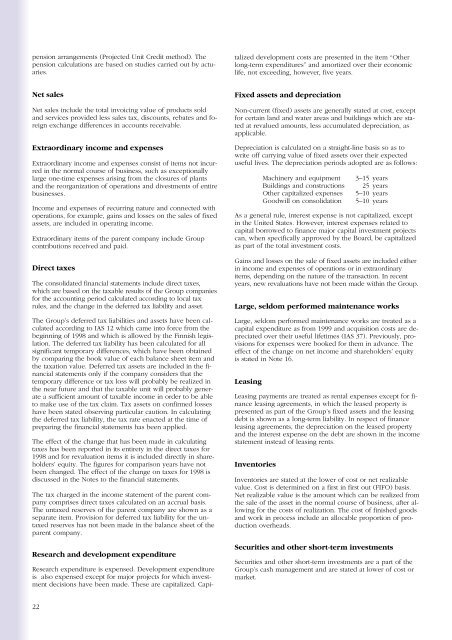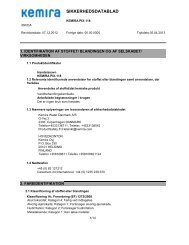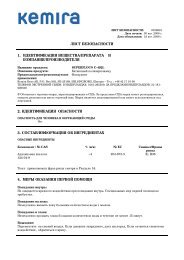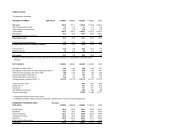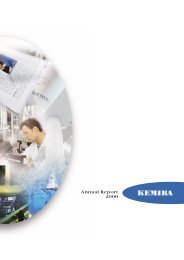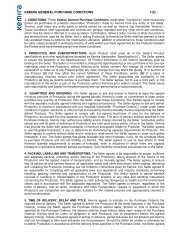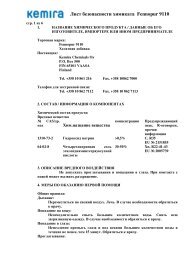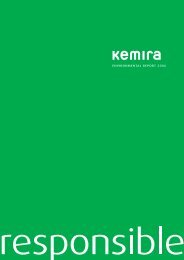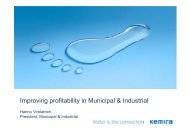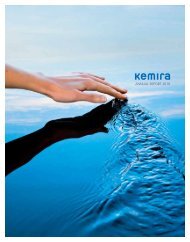Annual Report 1999 - Kemira
Annual Report 1999 - Kemira
Annual Report 1999 - Kemira
You also want an ePaper? Increase the reach of your titles
YUMPU automatically turns print PDFs into web optimized ePapers that Google loves.
pension arrangements (Projected Unit Credit method). The<br />
pension calculations are based on studies carried out by actuaries.<br />
Research expenditure is expensed. Development expenditure<br />
is also expensed except for major projects for which investment<br />
decisions have been made. These are capitalized. Capitalized<br />
development costs are presented in the item “Other<br />
long-term expenditures” and amortized over their economic<br />
life, not exceeding, however, five years.<br />
Net sales<br />
Net sales include the total invoicing value of products sold<br />
and services provided less sales tax, discounts, rebates and foreign<br />
exchange differences in accounts receivable.<br />
Extraordinary income and expenses<br />
Extraordinary income and expenses consist of items not incurred<br />
in the normal course of business, such as exceptionally<br />
large one-time expenses arising from the closures of plants<br />
and the reorganization of operations and divestments of entire<br />
businesses.<br />
Income and expenses of recurring nature and connected with<br />
operations, for example, gains and losses on the sales of fixed<br />
assets, are included in operating income.<br />
Extraordinary items of the parent company include Group<br />
contributions received and paid.<br />
Direct taxes<br />
The consolidated financial statements include direct taxes,<br />
which are based on the taxable results of the Group companies<br />
for the accounting period calculated according to local tax<br />
rules, and the change in the deferred tax liability and asset.<br />
The Group’s deferred tax liabilities and assets have been calculated<br />
according to IAS 12 which came into force from the<br />
beginning of 1998 and which is allowed by the Finnish legislation.<br />
The deferred tax liability has been calculated for all<br />
significant temporary differences, which have been obtained<br />
by comparing the book value of each balance sheet item and<br />
the taxation value. Deferred tax assets are included in the financial<br />
statements only if the company considers that the<br />
temporary difference or tax loss will probably be realized in<br />
the near future and that the taxable unit will probably generate<br />
a sufficient amount of taxable income in order to be able<br />
to make use of the tax claim. Tax assets on confirmed losses<br />
have been stated observing particular caution. In calculating<br />
the deferred tax liability, the tax rate enacted at the time of<br />
preparing the financial statements has been applied.<br />
The effect of the change that has been made in calculating<br />
taxes has been reported in its entirety in the direct taxes for<br />
1998 and for revaluation items it is included directly in shareholders’<br />
equity. The figures for comparison years have not<br />
been changed. The effect of the change on taxes for 1998 is<br />
discussed in the Notes to the financial statements.<br />
The tax charged in the income statement of the parent company<br />
comprises direct taxes calculated on an accrual basis.<br />
The untaxed reserves of the parent company are shown as a<br />
separate item. Provision for deferred tax liability for the untaxed<br />
reserves has not been made in the balance sheet of the<br />
parent company.<br />
Research and development expenditure<br />
Fixed assets and depreciation<br />
Non-current (fixed) assets are generally stated at cost, except<br />
for certain land and water areas and buildings which are stated<br />
at revalued amounts, less accumulated depreciation, as<br />
applicable.<br />
Depreciation is calculated on a straight-line basis so as to<br />
write off carrying value of fixed assets over their expected<br />
useful lives. The depreciation periods adopted are as follows:<br />
Machinery and equipment<br />
Buildings and constructions<br />
Other capitalized expenses<br />
Goodwill on consolidation<br />
3–15 years<br />
25 years<br />
5–10 years<br />
5–10 years<br />
As a general rule, interest expense is not capitalized, except<br />
in the United States. However, interest expenses related to<br />
capital borrowed to finance major capital investment projects<br />
can, when specifically approved by the Board, be capitalized<br />
as part of the total investment costs.<br />
Gains and losses on the sale of fixed assets are included either<br />
in income and expenses of operations or in extraordinary<br />
items, depending on the nature of the transaction. In recent<br />
years, new revaluations have not been made within the Group.<br />
Large, seldom performed maintenance works<br />
Large, seldom performed maintenance works are treated as a<br />
capital expenditure as from <strong>1999</strong> and acquisition costs are depreciated<br />
over their useful lifetimes (IAS 37). Previously, provisions<br />
for expenses were booked for them in advance. The<br />
effect of the change on net income and shareholders’ equity<br />
is stated in Note 16.<br />
Leasing<br />
Leasing payments are treated as rental expenses except for finance<br />
leasing agreements, in which the leased property is<br />
presented as part of the Group’s fixed assets and the leasing<br />
debt is shown as a long-term liability. In respect of finance<br />
leasing agreements, the depreciation on the leased property<br />
and the interest expense on the debt are shown in the income<br />
statement instead of leasing rents.<br />
Inventories<br />
Inventories are stated at the lower of cost or net realizable<br />
value. Cost is determined on a first in first out (FIFO) basis.<br />
Net realizable value is the amount which can be realized from<br />
the sale of the asset in the normal course of business, after allowing<br />
for the costs of realization. The cost of finished goods<br />
and work in process include an allocable proportion of production<br />
overheads.<br />
Securities and other short-term investments<br />
Securities and other short-term investments are a part of the<br />
Group’s cash management and are stated at lower of cost or<br />
market.<br />
22


